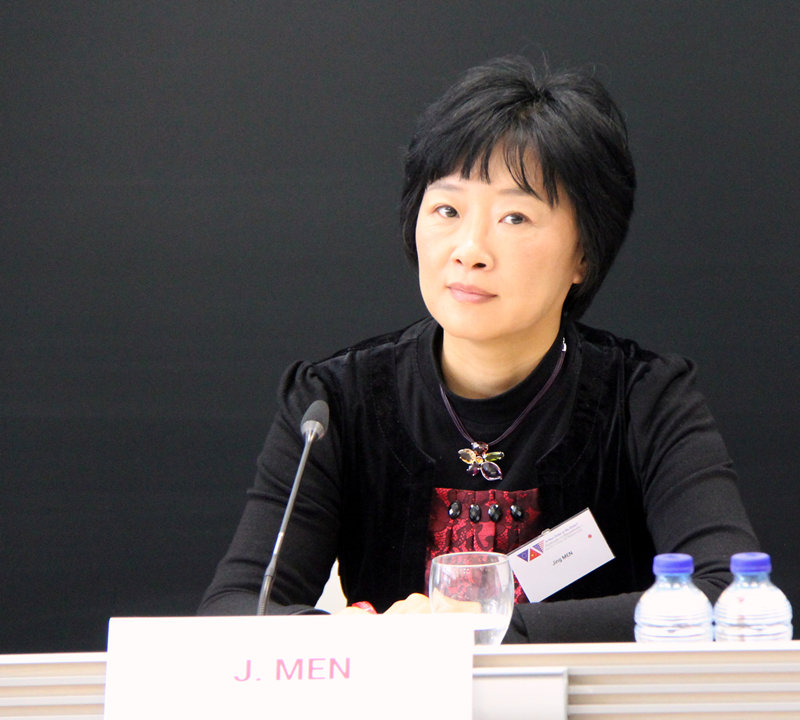
Profile Picture: Professor Men Jing
The 19th National Congress of the Communist Party of China (CPC), which will open on Wednesday, attractsglobal attention. The European academic community pays a lot of attention to the event. Prof. Men Jing, director of EU-China Research Centre, College of Europe in Belgium, is a well-known scholar in the field of EU-China relations.She shared with People's Daily correspondent her views on the upcoming Party Congress.
It will be a very important congress in the People's Republic of China's history not only because the Standing Committee of the Political Bureau of the CPC Central Committee will have new members, but also because new reforms will be introduced in Chinese political and economic system, and new policies will be implemented to stimulate development and to reinforce China’s hard and soft power in foreign relations. This Congress will, to a large degree, be a continuous effort to reaffirm all core Chinese national interests and development goals. The political report to be made at the Congress, apart from summarizing the achievements and lessons of the past five years, will address the internal and external challenges and draft a blueprint for China over the next decade.
Chinese people have been working hard to pursue the goal of becoming a“moderately developped country by 2020. This Congress will give a new push to reform policies for the goal to be realized in its final stage. In fact, this goal is in line with the "Two Centenaries" which serve as the basic foundation for achieving the "Chinese dream." In the past five years, under the leadership of President Xi Jinping, China became more proactive in pursuing national interests. In particular, the Belt and Road Initiative proposed by President Xi in late 2013 attracts worldwide attention due to China’s rising influence on global economic growth and global governance. The initiative includes more than 65 countries, 4.4 billion people and about 40 per cent of global GDP. The total trade volume between China and other Belt and Road countries between 2014 and 2016 exceeded $3 trillion, and China’s investment in these countries surpassed $50 billion. At the Belt and Road Forum in Beijing on May 15, a total of 68 countries and international organizations signed economic, trade, energy and other agreements with China to further the Belt and Road Initiative.
First, the Belt and Road Initiative is a long term project, the full impact of which will only be realized in the coming decades. The 19thCPC National Congress will continue to push for the five goals set for the initiative — policy coordination, facilities connectivity, unimpeded trade, financial integration and people-to-people bonds — which will have noticeable impact on EU-China relations in the coming years.
First of all, in terms of policy coordination, the Three Pillar institutional arrangements will be developed and more dialogue channels will established between the EU and China to exchange views and create more opportunities and platforms for cooperation. EU and China are negotiating the Comprehensive Agreement on investment, the conclusion of which will create a better investment environment for both European and Chinese investors in each other's market.
Second, infrastructure investment will be increased in both the EU and China. It is foreseeable that more Chinese investment will be directed to Central and Eastern Europe to upgrade regional transport network. Negotiations on infrastructure projects as part of EU-China Connectivity Platform will conclude in the near future, which will set examples of cooperation between EU and China, to encourage the two sides to further explore common ground and capitalize on complementarities.
Third, EU-China trade has been growing rapidly in recent years; China accounted for 15 percent of total extra-EU trade in goods in 2016, five percent higher than 2006. Over the same period, the share of China in extra-EU imports increased from 14 percent in 2006 to 20 percent in 2016, and its share in exports almost doubled — from 6 percent in 2006 to 10 percent in 2016. Boosted by improved connections between EU and China, the trade volume will expand further in the coming years.
Fourth, the Asian Infrastructure Investment Bank (AIIB) was created in 2015 with the support of 57 founding members from across the world. Two years later, more countries joined the bank, taking total membership to 80 by June 2017. Among them, nearly 20 countriesare EU members. A Chinese saying goes A good beginning makes a good ending.” The successful growth story of the AIIB, based on transparent rules and multilateral working mechanism, will help create a momentum for the EU and China to create more channels of financial cooperation.
Last, people-to-people contacts between Europe and China have expandedimpressively. A large number of exchange mechanisms have been established between the two sides, including education, culture and tourism. According to statistics, 544,500 Chinese students studied abroad in 2016. This number is said to reach 700,000 to 800,000 in the coming years. Chinese tourists to Europe numbering close to 5.5 million people, doubles in 2017. The 4th EU-China High-Level People-to-People Dialogue will be held in November in Shanghai. 2018 is the EU-China Year of Tourism. Closer contacts between peoples will improve mutual understanding, helping enhance bilateral ties.
Finally, the Congress will provide directions for China’s further development, through both domestic growth and international cooperation as part of the Belt and Road Initiative. The Congress will play an important role in highlighting China’s development priorities and identifying major challenges to safeguard the nation’s further rise as a regional and global player. The Congress can be understood as another milestone in the PRC’s history — its contribution to the realization of the “Chinese dream” will be fully appraised in the years to come.


